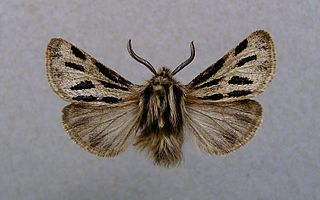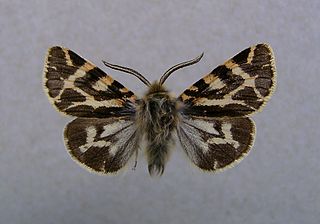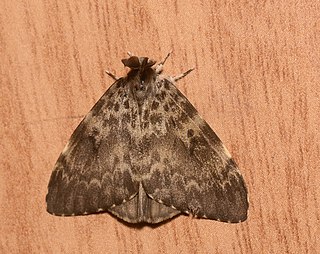
Lymantria dispar, also known as the gypsy moth or the spongy moth, is a species of moth in the family Erebidae. Lymantria dispar is subdivided into several subspecies, with subspecies such as L. d. dispar and L. d. japonica being clearly identifiable without ambiguity. Lymantria dispar has been introduced to several continents and is now found in Europe, Africa, Asia, North America and South America. The polyphagous larvae live on a variety of deciduous and coniferous trees and can cause severe damage in years of mass reproduction. Due to these features, Lymantria dispar is listed among the world's 100 worst invasive alien species.

The Lymantriinae are a subfamily of moths of the family Erebidae. The taxon was erected by George Hampson in 1893.

Jules Pierre Rambur was a French entomologist.

Ocnogyna is a genus of moths in the family Erebidae from western Eurasia. The genus was erected by Julius Lederer in 1853. One aberrant species, Ocnogyna parasita, has females with non-functional wings, and because of this was formerly placed in its own genus Somatrichia, but is now in Ocnogyna.

Lymantria is a genus of tussock moths in the family Erebidae. They are widely distributed throughout Europe, Japan, India, Sri Lanka, Myanmar, Java, and Celebes. The genus was erected by Jacob Hübner in 1819.

Agrotis vestigialis, the archer's dart, is a moth of the family Noctuidae. The species was first described by Johann Siegfried Hufnagel in 1766. It is found in most of the Palearctic realm from Ireland east, through to Russia, Siberia, the Altai mountains and the Amur region, and is also present in the Mediterranean Basin. It is absent from the north of Finland and Norway.

Lymantria mathura, the rosy gypsy moth, is a species of moth of the family Erebidae found in the Russian Far East, Nepal, Japan, the Korean Peninsula, northern India and China. The species was first described by Frederic Moore in 1866.

Ocnogyna baetica, also known as Rambur's Pellicle or winter webworm, is a moth of the family Erebidae. The species was first described by Rambur in 1837. It is found in Italy, the Iberian Peninsula and North Africa.

Lymantriini is a tribe of moths of the family Erebidae. This tribe is a group of polyphagous moths that reside mostly in the tropical regions of Afro-Eurasia but also North America.

Lymantria lunata, the luna gypsy moth, is a moth of the family Erebidae. The species was first described by Caspar Stoll in 1782. It is found in Southeast Asia, from India to the northeast coast of Australia.

Carterus is a genus of beetles in the family Carabidae, containing the following species:
Trymosternus is a genus of beetles in the family Carabidae, containing the following species:
Singilis is a genus of beetles in the family Carabidae, first described by Jules Pierre Rambur in 1837.

Lymantria concolor is a moth of the family Erebidae first described by Francis Walker in 1855. It is found in Sikkim, the Himalayas, Taiwan and Thailand.
Nebria andalusia is a species of ground beetle in the Nebriinae subfamily. In Europe, it can be found in such countries as Italy, Portugal, Spain, and on islands such as Malta and Sicily. It is also present in North Africa, in countries such as Algeria, Morocco, and Tunisia.
Brachinus andalusiacus is a species of ground beetle in the Carabinae subfamily that can be found in Spain and Morocco.

Lymantria ampla is a moth of the family Erebidae first described by Francis Walker in 1855. It is found in India and Sri Lanka.













